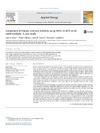Identificador persistente para citar o vincular este elemento:
https://accedacris.ulpgc.es/handle/10553/47327
| Campo DC | Valor | idioma |
|---|---|---|
| dc.contributor.author | Carta, José A. | en_US |
| dc.contributor.author | Cabrera, Pedro | en_US |
| dc.contributor.author | Matías, José M. | en_US |
| dc.contributor.author | Castellano, Fernando | en_US |
| dc.date.accessioned | 2018-11-23T12:39:26Z | - |
| dc.date.available | 2018-11-23T12:39:26Z | - |
| dc.date.issued | 2015 | en_US |
| dc.identifier.issn | 0306-2619 | en_US |
| dc.identifier.uri | https://accedacris.ulpgc.es/handle/10553/47327 | - |
| dc.description.abstract | Recent studies in the field of renewable energies, and specifically in wind resource prediction, have shown growing interest in proposals for Measure-Correlate-Predict (MCP) methods which simultaneously use data recorded at various reference weather stations. In this context, the use of a high number of reference stations may result in overspecification with its associated negative effects. These include, amongst others, an increase in the estimation error and/or overfitting which could be detrimental to the generalisation capacity of the model when handling new data (prediction).This paper analyses the benefits of feature selection for use with Artificial Neural Network (ANN) techniques with a multilayer perceptron (MLP) structure when the ANNs are used as MCP methods to predict mean hourly wind speeds at a target site. The features considered in this study were the mean hourly wind speeds and directions recorded in 2003 and 2004 at five weather stations in the Canary Archipelago (Spain).The two feature selection techniques considered in the analysis were the Correlation Feature Selection (CFS), which is a correlation-based filter approach (FA), and an MLP-based wrapper approach (WA). The metrics used to compare the results were the mean absolute error (MAE), the mean absolute percentage error (MAPE) and the index of agreement (IoA).Evaluation of the mean errors obtained in the 10-fold cross-validation tests for the year used to represent the short-term wind data period resulted in several conclusions. These included, notably, that the WA gave lower mean errors than the FA in 100% of the cases analysed independently of the metric employed. However, the FA resulted in a significant reduction in computational load and considerable enhancement of model interpretability. When very good correlation coefficients were obtained between the target and reference stations, no significant statistical difference was observed at 5% level between the three models (FA, WA and the models constructed with all the variables) in most of the cases analysed. | en_US |
| dc.language | eng | en_US |
| dc.relation.ispartof | Applied Energy | en_US |
| dc.source | Applied Energy [ISSN 0306-2619], v. 158, p. 490-507, (Noviembre 2015) | en_US |
| dc.subject | 3322 Tecnología energética | en_US |
| dc.subject.other | Wind power | en_US |
| dc.subject.other | Neural networks | en_US |
| dc.subject.other | Weather information services | en_US |
| dc.title | Comparison of feature selection methods using ANNs in MCP-wind speed methods. A case study | en_US |
| dc.type | info:eu-repo/semantics/Article | en_US |
| dc.type | Article | en_US |
| dc.identifier.doi | 10.1016/j.apenergy.2015.08.102 | en_US |
| dc.identifier.scopus | 84941050919 | - |
| dc.identifier.isi | 000364880800042 | - |
| dc.contributor.authorscopusid | 7003652043 | - |
| dc.contributor.authorscopusid | 56331565000 | - |
| dc.contributor.authorscopusid | 8058596200 | - |
| dc.contributor.authorscopusid | 57211016243 | - |
| dc.contributor.authorscopusid | 15748181300 | - |
| dc.description.lastpage | 507 | en_US |
| dc.description.firstpage | 490 | en_US |
| dc.relation.volume | 158 | en_US |
| dc.investigacion | Ingeniería y Arquitectura | en_US |
| dc.type2 | Artículo | en_US |
| dc.contributor.daisngid | 1198474 | - |
| dc.contributor.daisngid | 2885442 | - |
| dc.contributor.daisngid | 30320309 | - |
| dc.contributor.daisngid | 4314940 | - |
| dc.utils.revision | Sí | en_US |
| dc.contributor.wosstandard | WOS:Carta, JA | - |
| dc.contributor.wosstandard | WOS:Cabrera, P | - |
| dc.contributor.wosstandard | WOS:Matias, JM | - |
| dc.contributor.wosstandard | WOS:Castellano, F | - |
| dc.date.coverdate | Noviembre 2015 | en_US |
| dc.identifier.ulpgc | Sí | en_US |
| dc.contributor.buulpgc | BU-ING | en_US |
| dc.description.sjr | 2,912 | |
| dc.description.jcr | 5,746 | |
| dc.description.sjrq | Q1 | |
| dc.description.jcrq | Q1 | |
| dc.description.scie | SCIE | |
| item.grantfulltext | open | - |
| item.fulltext | Con texto completo | - |
| crisitem.author.dept | GIR Group for the Research on Renewable Energy Systems | - |
| crisitem.author.dept | Departamento de Ingeniería Mecánica | - |
| crisitem.author.dept | GIR Group for the Research on Renewable Energy Systems | - |
| crisitem.author.dept | Departamento de Ingeniería Mecánica | - |
| crisitem.author.orcid | 0000-0003-1379-0075 | - |
| crisitem.author.orcid | 0000-0001-9707-6375 | - |
| crisitem.author.parentorg | Departamento de Ingeniería Mecánica | - |
| crisitem.author.parentorg | Departamento de Ingeniería Mecánica | - |
| crisitem.author.fullName | Carta González, José Antonio | - |
| crisitem.author.fullName | Cabrera Santana, Pedro Jesús | - |
| Colección: | Artículos | |
Citas SCOPUSTM
39
actualizado el 08-jun-2025
Citas de WEB OF SCIENCETM
Citations
33
actualizado el 08-jun-2025
Visitas
142
actualizado el 24-ago-2024
Descargas
313
actualizado el 24-ago-2024
Google ScholarTM
Verifica
Altmetric
Comparte
Exporta metadatos
Los elementos en ULPGC accedaCRIS están protegidos por derechos de autor con todos los derechos reservados, a menos que se indique lo contrario.
